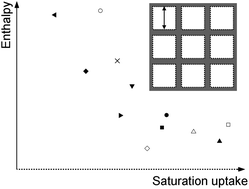Nanosponges for hydrogen storage
Abstract
Hydrogen storage by physisorption is a very promising technique due to its fast kinetics and full reversibility. The key to reach high storage capacities is high specific surface area. Extremely large surface areas can only be achieved by materials with high porosity, i.e., nanosponges like MOF-177 (4239 m2 g−1) and DUT-23(Co) (4850 m2 g−1). Even specific surface areas of more than 6000 m2 g−1 have been recently reported in the literature and these new materials reach hydrogen excess uptakes up to 9 wt% at 77 K. Within the novel class of metal–organic frameworks (MOFs), crystalline materials can be synthesized with well-defined pore structure and inner surface areas exceeding the best activated carbons. An overview is given on

- This article is part of the themed collection: Integrating functionality into metal–organic frameworks

 Please wait while we load your content...
Please wait while we load your content...